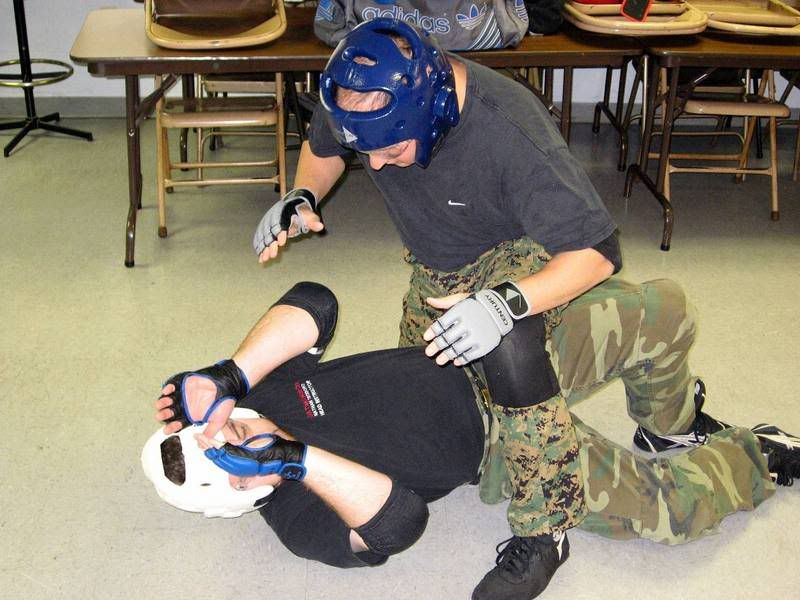
I posted a thread on CoCA a little while back to stimulate discussion on the benefits, if any, of point sparring for application in self defense. As expected, I got some interesting answers:
"...timing your opponent, maintaining proper distance, and fighting spirit or developing confidence. Otherwise, "playing the chess game" will get you stomped on the street. - Dojo Rat
"Point sparring is important for developing timing and confidence, however for a self defense version of a traditional sparring exercise, pull out the (sadly little-used) kohai ippon kumite." - Sensei Michael
"Ippon Kumite is an excellent drill, I try to utilize it often! It really helps students work out those natural, instinctual fears of having a strike coming at them, or striking at others, and it has a much different feel than lining up a few paces away from an opponent decked out in full pads. I like to have students begin ippon kumite from relaxed natural stances as well. This helps simulate the sometimes surprise element of getting attacked, when there is no time to set in defense and your opponent is trying to get in a sucker-attack." - Matt Apsokardu
"Seems to me that regular sparring would be much more beneficial in the long run. Personally, I find point sparring a little useless. Sorry!!" - Somaserious
What does this tell you? It tells me that everyone seems to know that point sparring is only a drill, not the real thing. For that matter, neither is boxing, MMA (even the UFC, sorry), BJJ, sticky or push hands, muay Thai, pro-wresting, or even the deadly thumb wrestling...
 All of these things are only a distant cousin of what really awaits us "out there." Cops will tell you about innocuous arguments that result in homicide, or domestic arguments that end up in tragedy. Sexual assault, muggings, racially motivated beatings, and plain old robbery all involve something other than the set rules and agreed-upon range of which all of our distractions and drills are comprised. In the same way Steve Irwin danced around the reality of nature, we flirt with the sharks from our cages.
All of these things are only a distant cousin of what really awaits us "out there." Cops will tell you about innocuous arguments that result in homicide, or domestic arguments that end up in tragedy. Sexual assault, muggings, racially motivated beatings, and plain old robbery all involve something other than the set rules and agreed-upon range of which all of our distractions and drills are comprised. In the same way Steve Irwin danced around the reality of nature, we flirt with the sharks from our cages.
Notice that all of the different systems and styles have a slightly different way of dealing with the same thing? All  martial arts and the sports they've spawned are expressing the values, theories, and philosophy of those who founded them. For example, my Arnis or Escrima is predicated upon the reality (or possibility) of a weapon being a knife, club, stick, or sword, and the sub-styles within it express their originators' flavors by varying the attacking point, stance, footwork, hand positions, grips, and even the standard weapon length and weight. A boxer may choose to slip where a karate (generic) exponent may choose to parry or block, where a grappler may choose to level change and shoot. I love that some systems like to "blend" or stick to an attack, where others will stop-hit or intercept. It's all good, isn't it? But none of it's real...
martial arts and the sports they've spawned are expressing the values, theories, and philosophy of those who founded them. For example, my Arnis or Escrima is predicated upon the reality (or possibility) of a weapon being a knife, club, stick, or sword, and the sub-styles within it express their originators' flavors by varying the attacking point, stance, footwork, hand positions, grips, and even the standard weapon length and weight. A boxer may choose to slip where a karate (generic) exponent may choose to parry or block, where a grappler may choose to level change and shoot. I love that some systems like to "blend" or stick to an attack, where others will stop-hit or intercept. It's all good, isn't it? But none of it's real...
Build your personal style around what you can do, what you'll likely have to do, where you're likely to have to do it, and with the clothing and weaponry you're likely to have. Take what you already know, and blend it into the scenarios and environments that make up your likely battleground. Then learn what you need to know, and fill in the areas, ranges, weapons and tactics that are missing in your tool chest. Train and prepare to go the distance while learning to finish quickly. Learn the ranges, techniques, tactic, and weapons that you're likely to face, and how to dominate someone in combat so that you can flee or fight as you need.
Last, build the confidence that comes from being prepared. Stay safe!
UPDATE:
Read Rick's posts at Kicks Boxes, "The Illusion of Reality," Pt1 and Pt2. A sample:
"...many martial art techniques are practiced in the dojo or gym under circumstances that make them appear effective but have little in common with the way people actually fight."
I also highly recommend Attack of the living dead by Patrick of Mokuren Dojo. In terms of insight, this is one of the best posts I've ever seen!
"To artistically represent anything there has to be some degree of abstraction from reality. The same is true in the abstraction of combat into martial art. There will necessarily be distortion. (Still not a really satisfying answer.) The trick is managing that distortion such that the martial art is still artistic but also still functional and practical."

No comments:
Post a Comment